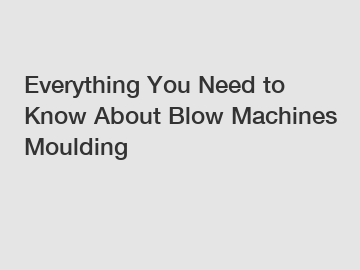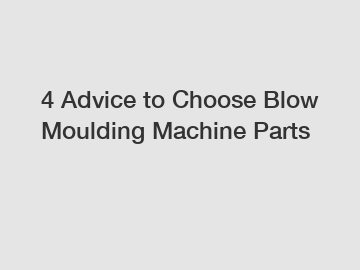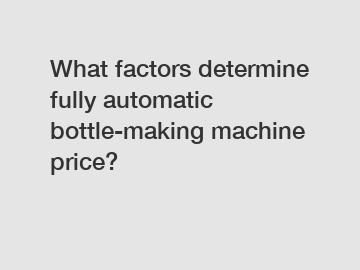The Ultimate Buyer's Guide for Purchasing Fully Automatic Blow Moulding Machine
How to choose fully automatic and semi-automatic blow ...
How to choose fully automatic and semi-automatic blow molding machines?
Are you interested in learning more about Fully Automatic Blow Moulding Machine? Contact us today to secure an expert consultation!
For the bottle blowing machine, many people who are new to the plastic bottle industry need to know and learn a lot before purchasing. They need to buy according to their own needs. So do you choose fully automatic or semi-automatic? So what's the difference between a fully automatic bottle blowing machine and a semi-automatic bottle blowing machine?
How to distinguish between fully automatic and semi-automatic blow molding machines?
First, the difference between a fully automatic bottle blowing machine and a semi-automatic bottle blowing machine:
1. The semi-automatic bottle blowing machine needs to go to the flash manually by itself
2. Fully automatic plastic bottle blowing machine realizes automation and directly produces the finished product, eliminating the labor of flashing in the middle. Saved labor. Under the same energy consumption, energy saving and high efficiency. The product quality is good and the bottle mouth is flat. There will be no overflow after closing the lid, which improves the qualification rate of the product. Orders will not be lost due to substandard products, which will damage the company's reputation.
How to choose a blow molding machine:
If your company's product demand is small and you are just starting this industry, you can choose a semi-automatic blow molding machine. Our company will send professional commissioning workers, from product ingredients to product molding and machine operation and maintenance, training is in place. Buying our equipment gives you no worries.
If your company's plastic barrels have a large demand, then go for a fully automatic bottle blowing machine. This equipment has high production efficiency, saves labor, and does not have the problem of poor management of labor. One master can look at multiple devices, reducing work intensity.
7 main components of the blow molding machine
1. Preform conveying structure of the bottle blowing machine: The unique mandrel conveying structure of the preform ensures that the preform will not be inverted when heated.
2. High-speed mold-clamping structure of the blow molding machine: The arc mold-clamping structure with independent intellectual property rights patent, special mold-clamping booster system, stable and noise-free high-speed operation.
3. Molding structure of hot-filling bottle for bottle blowing machine: When blowing hot-filling bottle, different required water / oil temperature is evenly distributed in different parts of the mold. The special design of the tee is used to make the crystallinity reach the required level. To achieve good results.
4. Lightweight energy-saving bottle blowing system: cold air combined with hot air, heating bottle mouth and transmission mandrel to cool, induction air device in the heating box to overcome air convection, to ensure the balance of preform heating temperature and prevent surface overheating.
5. Energy-saving sealing machine blowing combination valve: The control valve does not need pipeline connection, compact structure, simple commissioning and maintenance, reasonable high and low pressure gas consumption, and energy consumption control.
6. Simple and reliable manipulators: cam-link bar billets and picking manipulators are easy to operate, have good coordination and low manufacturing costs. Closed loop temperature control mode; preform temperature feedback compensation; quickly reach the steady state of preform heating.
7. Clean and safe design: The bottle blowing machine adopts a fully enclosed structure to ensure that the plastic environment is clean, eliminates external pollution of the bottle, and ensures the plastic cleanliness of large medical infusion bottles. Perfect and reliable safety door system to ensure the safety of operators and long-term operation stability of the blow molding machine.
For anything interest you, please feel free to contact us by
Whatsapp: 86-136-7018-1318
Email: johnlauvip@gmail.com
Website: www.steplead.com
Facility: https://youtu.be/1I0mypq9Na8
Purchasing Basics: Injection molding machines
Matching a molding machine to the jobs you will run is a key in the selection process.
Photo: Engel
Sometimes you go to purchase a molding machine for a specific job; sometimes you are looking for a machine to give you additional capacity for future parts, exact size and configuration unknown. Probably one of the most difficult aspects of purchasing a molding machine, particularly if it is not for a specific job, is ensuring that the quotes you solicit from different machinery manufacturers are comparable. Therefore, the more preparation done ahead of the request for quotation, the better the chance that the quotes will be comparable. Also, it is useful to explain the reasons behind certain unusual specifications so that you can be sure the machine you buy will meet your needs.
One good place to start is looking at any deficiencies of your existing equipment, in terms of performance, maintenance costs, downtime, or supplier service. Let's assume you know the application that's going to run in the machine. The next critical step is to get accurate data on the tool and the part. The mold's outside dimensions will affect the size of the machine's platens, and the projected area of the part (in square inches) determines the injection pressure and the size of the injection unit required. If you're planning to run several molds in the machine, make a spreadsheet that includes all the molds, and then use the largest dimension for each mold, except for wall thickness. For that, use the part wall thickness with the smallest measurement as your guide. These are the dimensions you will need:
When to add capacity
Using the rule-of-thumb method, a fairly standard annual capacity number is 70 percent. If you are looking to demonstrate the need for adding capacity, take the ideal number of available hours (hours per day available times number of days running per year) and reduce that ideal by multiplying by .70. This number takes into account a stable operation (one that is not increasing capacity by adding days or shifts), routine maintenance for tooling and machinery, and may leave a little room for the unplanned. This number is conservative if your shop has long runs of the same product. Conversely, a short-run shop with multiple material and tool changes may work hard to reach 70 percent.
The complete capacity or cost/benefit analysis approach uses as much information as you can gather about a specific project. Cost items to consider include the following: the initial purchase price; loan, buy, or lease costs; operating expenses (electricity, shop overhead for the specific area of the new equipment, lubricants, and fluids); spare parts inventory; shipping, rigging, and installation costs; new auxiliary equipment costs; and training expenses. Using these items instead of a standard machine rate requires more work but it separates costs into categories that can be studied for specific issues rather than setting press expense rates.—R. Caufman, RC Marketing Inc.
Mold width.
Mold length.
Mold stack height.
Mold opening distance.
Ejector rod spacing.
Center ring diameter.
Part dimensions.
Part wall thickness.
See also:
Which Fully Automatic Pet Bottle Blowing Machine Service Offers the Best Customization Options?
Mastering the Art of Plastic Film Production
Revolutionizing Manufacturing: Is Automated Blow Molding the Future?
Revolutionizing Bottle Blowing: The Future of Manufacturing?
Discover the Secrets of Unique Blow Molding Techniques
The Ultimate Guide to Single Stage Pet Blowing
When did blow molding start?Want more information on Detergent Bottle Blow Molding Machine? Feel free to contact us.
Part flow length.
Part weight.
Runner weight.
Number of parts.
Total shot weight.
Nozzle radius.
Material (and its viscosity).
If it's a multicavity mold, multiply the individual part dimensions by the number of cavities, or total all parts if they are not the same. However, if you are using a stack mold, you need to multiply part surface area by only 1.4 to get the total projected area. Also, remember that if you are planning on robotic ejection, allow for space for the robot to enter the mold and retract the parts in figuring your total daylight.
With these measurements, you or your supplier can analyze the injection pressure, both in the barrel and in the cavity, and the injection unit size required. The next step is to determine the clamp tonnage, based on defined injection pressure, projected area, and theoretical injection pressure. Once you've determined the clamping pressure, double-check that your mold will fit the tiebar spacing and that the opening stroke will allow your mold to open fully and get the part removed.
Rules of Thumb
If machine cycles are less than 6 seconds, the shot volume should not be larger than 20 percent of the total shot volume (the material needs a minimum residence time to fully melt).
To calculate minimum opening stroke of a molding machine, figure the stack height of your mold plus two times the core length, plus any space for an automatic part removal device.
The last step is to figure out which options are needed. One kind is required to produce and handle the parts. For example, what extra hydraulic functions will you need (such as core pulls, valve gates, inmold ejectors)? What air functions are required (valve gates, part blowoffs, core air, cavity air)? What about extra control functions? Will you need a robot or other auxiliary equipment interface, valve gate sequence control, mold heaters (electric or hot oil), nozzle shutoff, leveling pads, a special screw and barrel, and so forth? Other options are those that would be useful in improving machine operations, such as graphical operator interface, SPC/ SQC charts, quality control computer interface, or production monitoring interfaces (data logging, card readers, printers, cycle analysis, and so forth).
If you are currently molding this part, pass the appropriate information (current machine specs and any deficiencies you want to overcome) along to your prospective suppliers.
When quotes are returned, compare them on as equal a basis as possible. Evaluate each vendor's capabilities by looking at how the machines are built, if you can. Check out the machine's performance. Review the machine manuals, and ask how urgent spare parts orders are handled. Find out who provides customer training and telephone diagnostic assistance. Check supplier references.
Machine cost calculations
At IMM, we get more questions about hourly machine rates than about any other single subject. We bring you this formula developed by Krauss-Maffei in order to help you develop what you should charge. To determine the basic machine cost, put together the information on finance charges, auxiliary equipment cost, maintenance costs, building location costs, electricity usage, water usage, and any other miscellaneous costs. All these costs divided by the operation time will provide you with an hourly rate. See this example for a 150-ton molding machine with a 50 mm screw. Add this figure to labor cost (average hourly rate plus burden), material cost, secondary services, tool cost, overhead, and profit, and you have a basis for quoting.
Production data
Production days/year
No. of shifts
Hours/shift
Usage
= Production hours/year
Machine purchase cost
Machine
Options
Auxiliaries
Finance cost
= Total cost
Finance data
Annual interest
Depreciation (1/2/3 shift operation: 6/5/4 years)
Maintenance cost
Maintenance (%/year—1/2/3 shift operation: 3/4/5%)
Building location costs
Area required, sq ft
Factor
Cost (sq ft/month)
Current consumption costs
Institutional electrical power (kW)
Usage
Power cost ($/kWh)
Water cost
Water usage (cu ft/hour)
Water cost, cu ft
Miscellaneous cost ($/year)
Machine cost per hour
Depreciation
Interest
Location cost
Maintenance
Power
Water
Miscellaneous cost
Total machine cost each hour
Finally, don't forget to ask about rigging or setup costs. What will shipping charges be? Do you need CE certification on the machine? Any other engineering? If you communicate your objectives clearly to your potential supplier, you should end up with a comparable quotation. When the comparison of the less concrete attributes are completed, you should have your new supplier.
With our thanks . . .
. . . to the following machine suppliers, who helped with material that contributed to this article: Husky, Krauss-Maffei, Niigata, and Wabash.
Go to the IMM Almanac Online home page.
Contact us to discuss your requirements of Blow Molding Systems. Our experienced sales team can help you identify the options that best suit your needs.
How do I operate Youli's Fully Automatic Blow Molding Machine?
What is the 20 Liter Pet Jar Blowing Machine Price?
How to choose the best preform machine?
How to Find Affordable Water Tank Moulding Machine Price
Unleashing the Power: Is the Pet Blower Machine a Game-Changer for Grooming?
Comparing Pet Jar Blowing Machine Prices: Costs Revealed
What are the Key Questions to Ask When Ordering Pet Jar Blowing Machine?




